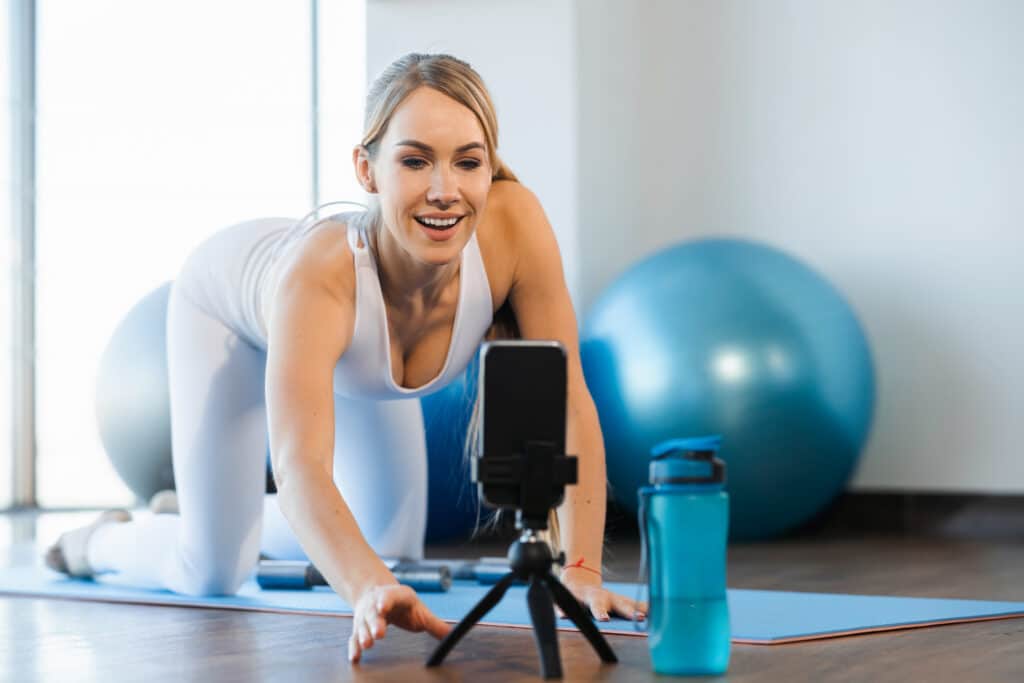Did you know that 68% of people in the US use social media for around 2-3 hours daily, checking their screens roughly 160 times a day? Social media is everywhere, meaning that it’s the perfect place to market your fitness business and get your brand in front of thousands – or even millions – of potential clients.
For this reason, having a social media strategy which generates brand awareness, attracts new clients and builds credibility is an essential part of standing out in the personal training market. You want content that will draw people in, keep them engaged, and make sure they stay. With a focus on social media, you have the opportunity to grow your community, gain more clients, and build your personal training brand. So here are our top tips for social media marketing success.
My PT Hub’s top tips for creating social media for fitness professionals
1. Choose the right social media platform.
Now it’s time to actually start building your social media presence. Not sure what platforms you should look at? No worries, read on and see our list of the best social media for you to start on.
Instagram: expand your reach with visual content
Instagram is a great starting point, especially for personal trainers. Insta has a huge user base – around 2 billion active monthly users – of all different ages and situations. It offers the ability to post photos, videos (Reels and Stories) and with Threads, you have access to a written post platform as well. It’s a great first social media platform to get used to posting and using all the tips we’ll give you to build your presence. It is also beneficial to expand your fitness brand across other platforms to reach a broader audience, once you have the hang of Instagram.
Read more: How To Start A Fitness Instagram
You can start slow on this. It’s much easier to build a following on a platform when you’ve already built up some authority – some of your audience will likely have multiple forms of social media, so if you have a good enough brand authority on one, you’ll have an instant following when you start on another. A social media strategy for a fitness business does not change majorly between platforms; it’s the content itself that changes. If you have multiple platforms, switching the content up between each social media platform is also going to build your credibility and push people into buying into your brand.
TikTok: Creative, short-form content for viral impact
TikTok excels at short, creative videos that can quickly reach a wide audience. Although many videos may not go viral, the platform encourages versatility and creativity in content creation. With TikTok’s ability to create playlists on the top of their page, people can easily access the content that resonates with them most. For example, if you post lots of stretching videos for flexibility, add it to a playlist so that people can easily find similar content on your channel that they find useful – in short, it’s a great way of organising your content. With TikTok’s younger demographic, it is ideal for coaches targeting clients between the ages of 18-34, as almost 70% of TikTok users are in this age demographic, and it is a great space for playful, innovative content. When thinking about starting a fitness TikTok, consider pairing it with Instagram to reinforce your message across multiple platforms.
Facebook: Connecting with communities and running local ads
Facebook is a valuable tool for connecting with local communities and running targeted ads. When thinking about Facebook marketing for fitness pros, remember it may not be ideal for high-engagement posts, but it can still be a great way to extend your reach. Many personal trainers find Facebook best suited to managing a thriving online community via Facebook’s Groups feature. With 35% of users being within the age range of 35-54 you will likely be catering to a slightly older audience compared to the other platforms, which is important to remember when thinking about your target audience.
YouTube: Educational videos and long-form tutorials
YouTube is the ideal platform for long-form content, like in-depth tutorials and educational videos. It complements platforms like Instagram and TikTok by offering space to expand on shorter content, such as creating full-length workouts or detailed fitness guides, but also offers the opportunity to post short-form videos through the Shorts feature. If you’re considering starting a YouTube fitness channel, repurpose or expand existing content for a strong launch.
LinkedIn: Establishing authority and networking with industry professionals
LinkedIn is ideal for networking with other professionals and showcasing your expertise. It’s less about marketing your services directly and more about sharing insights, research, or theoretical perspectives to build credibility and establish yourself as a thought leader. For example, if you have unique views on anatomy or trends in fitness, LinkedIn is a great place to spark meaningful conversations and collaborations. It will help cement yourself as an expert in your field, showcasing theoretical skills that will make you a more valuable personal trainer. If your fitness business is centered around corporate wellness or targets high-end professional clients, an active LinkedIn profile is a great way for you to get in front of your ICP (Ideal Customer Profile).

2. Create engaging content
Creating engaging fitness content for social media is all about providing value while keeping it authentic and visually captivating. Your audience craves content that educates and inspires, so share workout tips, fitness hacks, and motivational client stories that resonate with their needs. High-quality visuals—think crisp videos and eye-catching infographics—are essential to grab attention and make your posts stand out. Don’t forget to sprinkle in your personality! Sharing behind-the-scenes moments or your unique fitness philosophy builds trust and relatability.
Variety is key to keeping your followers hooked. Mix up your content with tutorials, quick fitness challenges, or live sessions to keep things fresh and exciting. Engage your audience directly by using interactive features like polls, Q&A sessions, and comments to create meaningful conversations with your followers. To expand your reach, leverage relevant hashtags, geotags, and trending topics to make your posts more discoverable. Most importantly, stay consistent with your posting schedule—reliable content builds credibility and keeps your audience coming back for more.
By combining value, authenticity, and engagement, your fitness content can turn casual scrollers into loyal followers and, ultimately, into dedicated clients.

3. Build a strong brand identity
When it comes to building your fitness brand on social media, having a clear, strategic plan is the secret sauce for success. Start by identifying your audience and crafting content that speaks directly to their fitness goals and challenges—whether it’s beginner-friendly workout routines, advanced fitness hacks, or motivational success stories. When you know your market, start crafting your brand identity – how you want to be seen on your socials. This will often be your potential client’s first impression of you, so make sure that it counts! Try to make your content and profile visually appealing with top-notch videos and graphics, and grab attention instantly.
Next, embrace authenticity – this will be key to creating a likeable and popular brand identity. Diversify your content with tutorials, live sessions, and engaging stories to keep things fresh and fun. Engagement will boost your account and let the social media platform know your content is good. Stay consistent with your posting schedule—reliability builds trust and keeps your followers excited to see what’s next. With the right strategy in place, your social media can become a powerful tool for connecting with your audience and growing your fitness business.

4. Create a good community, connect with them, and always re-engage:
Building a thriving online community starts with meaningful connections. Authenticity is at the core—show your audience the real you through behind-the-scenes content, personal stories, and relatable moments. People connect with genuine experiences, so let your personality shine in your posts and interactions.
Engagement is another key element. Features like polls, Q&A sessions, and direct responses to comments help create a dialogue with your followers, making them feel heard and valued. Additionally, a consistent presence reassures your audience that you’re committed to fostering a supportive environment. By combining authenticity, interaction, and reliability, you’ll cultivate a loyal community that sees you not just as a trainer but as a trusted partner in their fitness journey.
Social media content ideas for personal trainers
If you’re feeling stuck on what to post on a personal trainer’s social media. Here are some suggestions.
1. Use client testimonials
When you’re feeling stuck for ideas, look no further than your own clients. Showcasing your clients’ fitness journeys, achievements, and transformations is one of the most powerful ways to create authentic, engaging content. Real-life success stories act as strong social proof, helping potential clients trust in your ability and buy into your brand. Start by highlighting milestones—whether it’s a client’s first pull-up, a major weight loss achievement, or simply their commitment to a healthier lifestyle. These stories resonate deeply because they are relatable, inspiring, and showcase your skills as a trainer in a natural, non-salesy way. Make sure you have your client’s permission first, and involve them in the process—many will feel proud to share their success.
2. Exercise demonstrations & technique
Filming and sharing short, instructional workout videos is one of the best ways to add value to your followers. Focus on clear demonstrations that highlight proper form, modifications for different fitness levels, and simple progressions. Think about workouts your audience can try at home or in the gym. By consistently offering useful, easy-to-follow workout demos, you’ll quickly establish yourself as a go-to fitness expert.
3. Educational content
Social media is a brilliant platform for educating your audience. Share helpful tips on training techniques, nutrition advice, recovery strategies, and ways to prevent injury. You can also debunk common fitness myths or explain the science behind why certain methods work. Educational content positions you as a reliable, knowledgeable source, helping to build authority and trust, without having to resort to the hard sell.
4. Basic workouts
These can act as a precursor to what you might offer, a trailer for your main personal training service. If people like your style of training on social media, they might sign up for your programs. This is also a great way of introducing new people to fitness, especially if someone has never done a higher-intensity workout or program before.
Remember, potential clients are more likely to trust a trainer who can demonstrate real-world results rather than just talk about them. Let your current clients be your best advocates and your greatest source of inspiration when creating content.

Next steps: converting your followers into paying clients
Once you’ve built up your social following, wouldn’t it be great to convert your followers into paying clients? That’s where My PT Hub comes in! With our all-in-one personal training software and app, you can easily connect your app with your social profiles to onboard new clients, deliver online content and introduce them to free taster programs or paid packages.
Want to learn more about how we help over 130,000 fitness professionals to successfully simplify, streamline and scale their fitness businesses?
Sign up to your 30-day free trial of My PT Hub today!
Social media for fitness professionals FAQs
How long does it take to grow a personal training business on social media?
Building a successful social media presence takes time and consistency. While targeted ads or trending content can deliver faster results, it generally takes several months of regular posting and audience engagement to establish trust and grow your following. Stay consistent, provide value, and focus on connecting with your audience to achieve sustainable growth.
What common mistakes should personal trainers avoid on social media?
- Focusing too much on selling: Instead of pushing constant promotions, share content that educates, inspires, and engages your audience.
- Ignoring interactions: Not replying to comments or DMs can make you seem disconnected. Active engagement fosters trust and loyalty.
- Inconsistent posting: Gaps in your posting schedule can reduce visibility and make it harder to build a dedicated following.
Which social media platforms work best for personal trainers?
- Instagram and TikTok: Great for showcasing workouts, fitness tips, and client transformations through short-form and visually engaging content.
- Facebook: Useful for connecting with local communities, building a community via Groups and running targeted ads.
- YouTube: Ideal for sharing long-form educational videos to establish your expertise.
- LinkedIn: Perfect for networking with other professionals and showcasing your knowledge in areas like fitness trends or anatomy.




